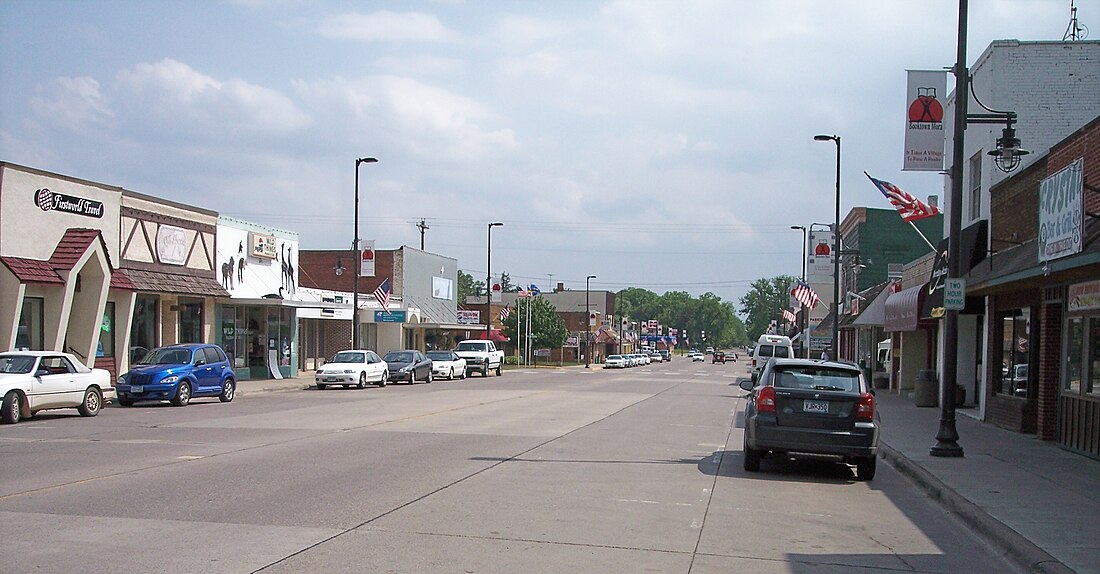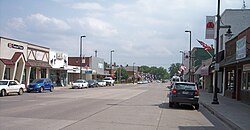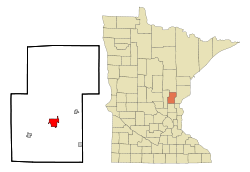Top Qs
Timeline
Chat
Perspective
Mora, Minnesota
City in Minnesota, United States From Wikipedia, the free encyclopedia
Remove ads
Mora is a city and the county seat of Kanabec County, Minnesota[4] It is located at the junction of Minnesota highways 23 and 65 and is along the Snake River. The population was 3,665 at the 2020 Census.[5]
Remove ads
History
Mora was platted in 1882[6] by Myron Kent.[7] The city was named after Mora, Sweden. when Israel Israelson suggested the name of his hometown in Dalarna County, Sweden.[7][6] The post office opened February, 27th, 1883 with Kent being the first postmaster of Mora.[7][8]
Geography

According to the United States Census Bureau, the city has a total area of 5.27 square miles (13.65 km2), of which 5.00 square miles (12.95 km2) is land and 0.27 square miles (0.70 km2) is water.[9]
Mora is located 72 miles north of Minneapolis-St. Paul at the intersection of Minnesota highways 23 and 65. It is also 52 miles northeast of St. Cloud and 91 miles southwest of Duluth.
Mora is along the Snake River.
Remove ads
Demographics
Summarize
Perspective
2020 Census
As of the census of 2020, there were 3,665 people, and 1,481 households.[10]
2010 Census
As of the census[11] of 2010, there were 3,571 people, 1,513 households, and 857 families living in the city. The population density was 714.2 inhabitants per square mile (275.8/km2). There were 1,684 housing units at an average density of 336.8 per square mile (130.0/km2). The racial makeup of the city was 98.4% White, 0.2% African American, 0.3% Native American 0.3% from other races, and 0.9% from two or more races. Hispanic or Latino of any race were 2.2% of the population.
There were 1,513 households, of which 28.1% had children under the age of 18 living with them, 37.6% were married couples living together, 13.4% had a female householder with no husband present, 5.6% had a male householder with no wife present, and 43.4% were non-families. 37.8% of all households were made up of individuals, and 20.3% had someone living alone who was 65 years of age or older. The average household size was 2.21 and the average family size was 2.87.
The median age in the city was 39.6 years. 23.4% of residents were under the age of 18; 8.4% were between the ages of 18 and 24; 23% were from 25 to 44; 23.3% were from 45 to 64; and 21.8% were 65 years of age or older. The gender makeup of the city was 47.2% male and 52.8% female.
2000 Census
As of the census[3] of 2000, there were 3,139 people, 1,381 households, and 814 families living in the city. The population density in the year 2000 was 781.2 per square mile (301.4/km2). There were 1,471 housing units at an average density of 359.9 per square mile (139.0/km2). The racial makeup of the city was 96.71% White, 0.28% African American, 1.28% Native American, 0.19% Asian, 0.03% Pacific Islander, 0.25% from other races, and 1.25% from two or more races. 1.57% of the population were Hispanic or Latino of any race.
There were 1,381 households, out of which 29.2% had children under the age of 18 living with them, 43.2% were married couples living together, 11.8% had a female householder with no husband present, and 41.0% were non-families. 36.9% of all households were made up of individuals, and 21.2% had someone living alone who was 65 years of age or older. The average household size was 2.23 and the average family size was 2.89.
In the city, the population was spread out, with 24.3% under the age of 18, 8.2% from 18 to 24, 24.3% from 25 to 44, 19.9% from 45 to 64, and 23.3% who were 65 years of age or older. The median age was 40 years. For every 100 females, there were 84.6 males. For every 100 females age 18 and over, there were 80.7 males.
The median income for a household in the city was $30,566, and the median income for a family was $40,577. Males had a median income of $32,222 versus $21,797 for females. The per capita income for the city was $17,949. 9.0% of the population and 6.0% of families were below the poverty line. Out of the total population, 7.7% of those under the age of 18 and 10.1% of those 65 and older were living below the poverty line.
Remove ads
Infrastructure
Historical
On October 27, 1882 the first train to arrive in Mora was a construction train pulled by a wood burner locomotive, eventually the town would be linked to the Hinckley branch of the Minneapolis- St. Cloud line.[12]
Transportation
Mora is served by the Mora Municipal Airport,[13] and Timber Trails Transit, a bus service in Kanabec and Mille Lacs counties.
Major highways
The following routes are located within the city of Mora.
The following county roads also serve as important routes in the city of Mora.
Remove ads
Arts and Culture

Mora is the home of a gigantic Dala horse, and a Mora clock commemorating the town's Swedish roots. Mora's sister city and namesake is Mora, Sweden, known for being the ending point of the Swedish Vasaloppet. They became sister cities in 1972 when the Dala horse was dedicated.[14]
The city of Mora also plays host each February to the Vasaloppet USA, the largest cross-country skiing event in Minnesota, as well as the Snake River Canoe Race, the Mora Half-Marathon, and the Mora Bicycle Tour.
Remove ads
Economy
Top employers
According to the city's 2022 Comprehensive Annual Financial Report (CAFR),[15] the top employers in the city are:
Remove ads
Climate
Remove ads
Notable people
- Roger Crawford, state representative
- Bill Diessner, state senator and physician
- Alice Frost, actress
- Gladys Nordenstrom, contemporary classical composer
- Henry Rines, Minnesota state treasurer and speaker of the Minnesota House of Representatives
- Judy Soderstrom, state representative and businesswoman
- Dan Stevens, state senator[18]
References
External links
Wikiwand - on
Seamless Wikipedia browsing. On steroids.
Remove ads


